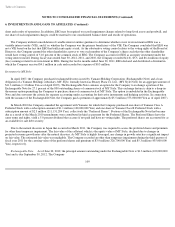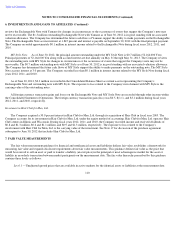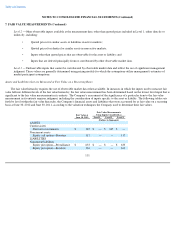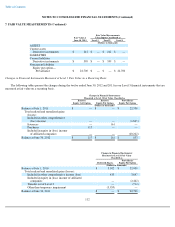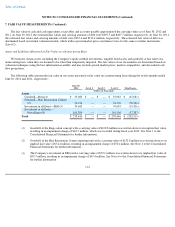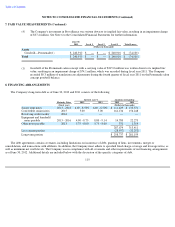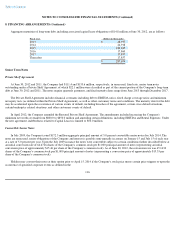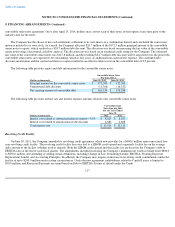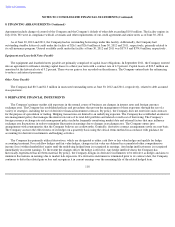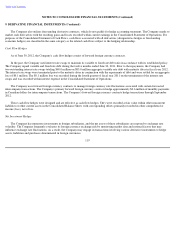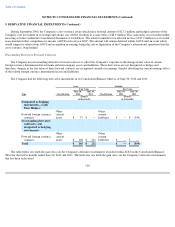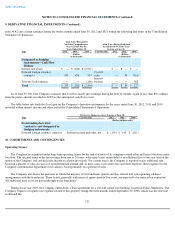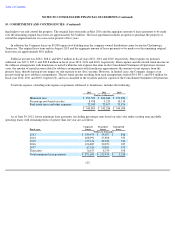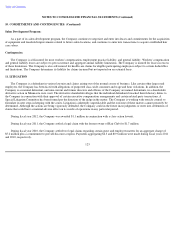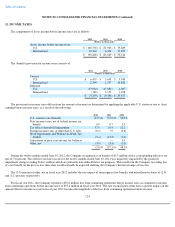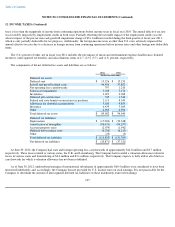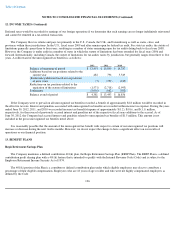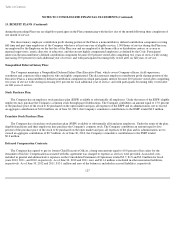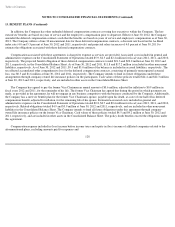Supercuts 2012 Annual Report Download - page 121
Download and view the complete annual report
Please find page 121 of the 2012 Supercuts annual report below. You can navigate through the pages in the report by either clicking on the pages listed below, or by using the keyword search tool below to find specific information within the annual report.
Table of Contents
NOTES TO CONSOLIDATED FINANCIAL STATEMENTS (Continued)
8. FINANCING ARRANGEMENTS (Continued)
Agreement include change of control of the Company and the Company's default of other debt exceeding $10.0 million. The facility expires in
July 2016. We were in compliance with all covenants and other requirements of our credit agreement and senior notes as of June 30, 2012.
As of June 30, 2012 and 2011, the Company had no outstanding borrowings under this facility. Additionally, the Company had
outstanding standby letters of credit under the facility of $26.1 and $26.0 million at June 30, 2012 and 2011, respectively, primarily related to
its self-insurance program. Unused available credit under the facility at June 30, 2012 and 2011 was $373.9 and $374.0 million, respectively.
Equipment and Leasehold Notes Payable
The equipment and leasehold notes payable are primarily comprised of capital lease obligations. In September 2011, the Company entered
into an agreement to refinance existing capital leases to a three year term with a contract rate of 4.9 percent. Capital leases of $20.5 million are
amortized at the historical rate of 9.2 percent. There was no gain or loss recorded on the refinance. The Company entered into the refinancing
to reduce cash interest payments.
Other Notes Payable
The Company had $0.3 and $1.3 million in unsecured outstanding notes at June 30, 2012 and 2011, respectively, related to debt assumed
in acquisitions.
9. DERIVATIVE FINANCIAL INSTRUMENTS
The Company's primary market risk exposures in the normal course of business are changes in interest rates and foreign currency
exchange rates. The Company has established policies and procedures that govern the management of these exposures through the use of a
variety of strategies, including the use of derivative financial instrument contracts. By policy, the Company does not enter into such contracts
for the purpose of speculation or trading. Hedging transactions are limited to an underlying exposure. The Company has established an interest
rate management policy that manages the interest rate mix of its total debt portfolio and related overall cost of borrowing. The Company's
foreign currency exchange rate risk management policy includes frequently monitoring market data and external factors that may influence
exchange rate fluctuations in order to minimize fluctuation in earnings due to changes in exchange rates. The Company enters into
arrangements with counterparties that the Company believes are creditworthy. Generally, derivative contract arrangements settle on a net basis.
The Company assesses the effectiveness of its hedges on a quarterly basis using the critical terms method in accordance with guidance for
accounting for derivative instruments and hedging activities.
The Company has primarily utilized derivatives, which are designated as either cash flow or fair value hedges and qualify for hedge
accounting treatment. For cash flow hedges and fair value hedges, changes in fair value are deferred in accumulated other comprehensive
income (loss) within shareholders' equity until the underlying hedged item is recognized in earnings. Any hedge ineffectiveness is recognized
immediately in current earnings. To the extent the changes offset, the hedge is effective. Any hedge ineffectiveness the Company has
historically experienced has not been material. By policy, the Company designs its derivative instruments to be effective as hedges and aims to
minimize fluctuations in earnings due to market risk exposures. If a derivative instrument is terminated prior to its contract date, the Company
continues to defer the related gain or loss and recognizes it in current earnings over the remaining life of the related hedged item.
118



